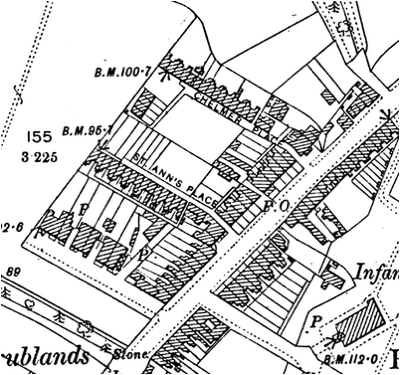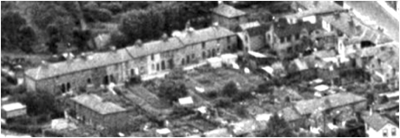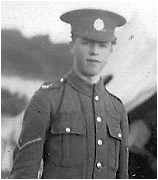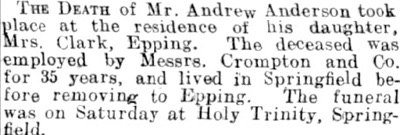labourer; in 1883, 1888 and 1890 he had been a stonemason. In 1891 Percy’s parents had been resident at 5 Chelmer Place. Two years later his father was employed as a labourer.
Percy was christened at Springfield Holy Trinity on 16th January 1898; at the time his father was employed as a packer at Crompton & Co.
Percy’s elder siblings were Stena Emily Andersen (born 1878 and christened at Springfield Holy Trinity Church on 6th October 1878), Septimus Andersen (born in 1881 and christened at Springfield Holy Trinity Church on 6th March 1881), Caroline Andersen (born on 3rd July 1883 and christened at Springfield Holy Trinity Church on 2nd September 1883), Minnie Elizabeth Andersen (born c1887 and christened at Springfield Holy Trinity Church on 22nd January 1888), Clara Andersen (born in 1889 and christened at Springfield Holy Trinity Church on 13th April 1890) and Alfred Ludwig Andersen (born on 29th January 1893 and christened at Springfield Holy Trinity Church on 13th August 1893). All were born in Springfield.
The 1901 census found Percy at 8 Chelmer Place, Springfield, a short road beside the Oddfellows Arms in Springfield Road and long since demolished (see map and photo below). Aged 5, he was living with his parents and three siblings. His father was a packer at an engineer’s work. A decade later the 1911 census recorded 15 year-old Percy, employed as a houseboy, living with his parents and siblings Clara and Alfred at 5 Chelmer Place. His father was a packer at Crompton’s Arc Works; his sister Clara was a domestic servant, and his brother Alfred a wood machinist’s labourer.
ANDERSEN, PERCY,
Sergeant, 1/5th Battalion, Essex Regiment
Following its withdrawal from Gallipoli the battalion landed in Alexandria, Egypt on 17th December 1915. On 28th December 1915 it was sent to El Hamam, Egypt where it formed part of the Western Frontier Force. On 5th March 1916 the battalion left for Mena Camp near Cairo, Egypt, before it was moved eastwards to protect the Suez Canal and its vital supply route, in an area known as the Southern Canal Section, from Turkish attacks across the Sinai Peninsula. The battalion remained there until January 1917.
By early 1917 the Turkish forces that had been threatening Egypt were being steadily driven back across the Sinai Peninsular towards Palestine by the advancing Allies. The 1/5th Battalion of the Essex Regiment spent most of February crossing the Peninsular and by late March 1917 was close to the Palestine town of Gaza, then still held by the Turks. The town was of strategic importance and had to be captured by the Allies if they were to succeed in their objective of driving the Turkish army northwards out of Palestine and thus isolating other Turkish forces in Mesopotamia and the Arabian Peninsular.
The initial attack to capture Gaza, known as the First Battle of Gaza, began early on 26th March 1917. The 161st Brigade, including the 1/5th Battalion of the Essex Regiment captured a hill known as Green Hill south-west of Ali el Muntar on the southern outskirts of Gaza. It was done so at a price - the Commonwealth War Graves Commission lists 117 fatalities for the battalion on 26th March 1917 plus 113 in the 1/4th Battalion of the Essex Regiment. Among them were ten Chelmsford men. The heavy casualties were mainly caused by the steady fire of three Turkish machine guns and one automatic rifle, aided by their protected position and perfect lateral filed for cross fire. Those losses were made more bitter by the decision, based on poor intelligence and communications, to withdraw Allied forces from their captured positions that night when in reality the town was their for the taking.
On 17th April 1917 a second attempt to capture Gaza, by then heavily reinforced by the Turks, was started by the Allies. Percy’s battalion participated in the action. Some progress was made despite determined opposition and heavy casualties (many suffered by the Norfolk Regiment), but the breakthrough the Allies needed could not be achieved and Gaza remained in Turkish hands. The town would not fall to the Allies until 7th November 1917 at the conclusion of the Third Battle of Gaza.
During the period between the Second and Third Battles of Gaza the 1/5th Battalion of the Essex Regiment spent much of its time in trenches facing Turkish forces near to Gaza and the Mediterranean Sea.
On the morning of 1st November 1917 the battalion received news that it was to launch an attack towards Gaza in the early hours of the following morning. The attack was planned as part of a deception designed to convince the Turks that a major assault would be made direct on Gaza, while the main Allied advance was in fact taking place some 30 miles to the east near Beersheba. From Beersheba the Allies would strike westwards towards the coast, threatening to encircle Gaza.
A and D Companies of Percy’s battalion were to attack the Rafa Redoubt. B Company, and two platoons of C Company were to take Zowaid Trench which lay immediately to the south (and to its right from the battalion’s starting position). Tanks would support both assaults. The remainder of C Company were in reserve while comrades from the 1/6th and 1/7th Battalions of the Essex Regiment were to assault other Turkish positions in the area, including Beach Post, Sea Post Cricket redoubt and the Rafa-Belah trench which ran northwards from Rafa Redoubt.
At 4.30 p.m. on 1st November 1917 a short service was held for Percy’s battalion, which was well attended. Half an hour later the battalion’s troops went to sleep. At 11 p.m. a ‘good square hot meal’ was served with a pint of beer to wash it down, to the accompaniment of an artillery duel began between the Allies and Turks. The bombardment continued until 1 a.m., and by 2.30 a.m. the battalion’s troops were in position for the attacks, timed to start at 2.55 a.m. The battalion consisted of 25 officers and 925 other ranks. A post-war account of the battalion by its commander continued:
“Silence reigned supreme and we stood unscathed on ground, which an hour before had been a veritable inferno. It was a good start. The tanks had got over safely and at 2.55 the Companies moved off. At three precisely, the artillery commenced. The moon had just disappeared and the light was very bad. The smoke and dust of the fire made a thick fog and the compass had to be relied upon for direction....After about half-an-hour a runner got back to say that the enemy’s front line was in our hands....The Turks had put up a wonderful fight, many of them lying in forward positions in the open to avoid the bombardment, and meeting our men with the bayonet.
Still the reports were very confusing, as both attacking parties claimed to be in the Rafa redoubt. No word was received as to the Zowaid trench. Runners lost their way in the thick haze and it was impossible to tell exactly what the situation was. The air seemed filled with fine sand and smoke, which hung about like a thick ground fog and made it very difficult.
Reports came in from the right that attacks on El Arish Redoubt and El Burj trench had been repulsed. I was very anxious about Zowaid, which joined El Burj. The reports, however, proved incorrect. It was now broad daylight and the enemy was firing furiously from his second line. The 6th [Essex] had taken Beach and Sea Posts with little trouble. The 7th [Essex] had taken Cricket redoubt. bit had not succeeded in their attack on the very important trench the Rafa-Belah. The tanks had broken down and neither had reached even its first objective. The loss of their support was a serious blow for the 7th.
The morning wore on and still no more definite news of Zowaid.”
Over the next few hours news emerged that B Company, whose objective had been Zowaid Trench had lost direction in the darkness and struck Rafa instead - the objective of A and D Companies. A swarm of men from B Company had been spotted by the commander of D Company, Lt. E. B. Deakin, clambering up the steep sandy slope which led up to Rafa Redoubt. Realising the error Lt. Deakin then took his men to attack Zowaid Trench instead which was captured by A and D Companies, who suffered heavy casualties in doing so. Men from C Company also entered Rafa Redoubt, but the Rafa-Belah trench held out and inflicted heavy casualties on the 7th and 10th Battalions of the London Regiment who were fighting nearby. The post-war account continued:
“It [the Rafa-Belah trench] was effectively blocked from the Rafa redoubt end, where [2nd Lt.] Archer did great work with his Lewis gun, fighting it himself almost single-handed after Sergeant C. T. Allaway, his most efficient Lewis gun non-commissioned officer, had been killed and most of the team knocked out. C.-S.-M. Wilson did splendid work in helping to organise and consolidate the position. Richmond and Lockwood, I remember, were conspicuous too, in Rafa redoubt; but it is hardly fair to mention names, there were so many others.”
The battalion managed to reinforce and retain both Rafa Redoubt and Zowaid Trench despite further attacks and heavy artillery fire from the Turks. Writing after the war the battalion’s commander stated:
“The capture of the Rafa redoubt and Zowaid trench was a feat of which the Battalion may well be proud. That the enemy offered a determined resistance was shown by the fact that our casualties in the action were two officers and 73 other ranks killed, seven officers and 172 other ranks wounded and nine other ranks missing. The killed included....such good non-commissioned officers as Sergts. H. Byles, N Bruce and D. Ambrose, Corpl. P Andersen, and L/Corpl. H. Quilter and Tasker.”
Percy was one of those 73 killed in action. In addition to Percy, a further six men commemorated by the Chelmsford War Memorial were also killed in the attack. They were: Charles Thomas Allaway, William J. M. Cooper, Stanley William Ellis, Ernest Horrex, Arthur Stanley Tasker and Bertram Harry Wright.
As hoped for, the attack succeeded in not only capturing the Turkish positions it also succeeded in its strategic aim, which was to keep the Turkish forces tied to Gaza and to draw a large number of troops to reinforce the defence of the town. Allied forces were to continue to advance from the east and on 7th November the Turks abandoned Gaza and retreated to the north.
On 7th December 1917 the Essex Weekly News reported:
“Springfield men reported killed include Sergt. Percy Anderson, Essex Regt., son of Mr. and Mrs. Anderson, Chelmer-place; Sergt. W. Cooper D.C.M., adopted son of Mrs. Linnett, of St. Ann’s-place; Pte. Stanley W. Ellis, Essex Regt., son of Mr. and Mrs. W. Ells, Chelmer-place; and Pte. F. C. Hunt, A.S.C., Mechanical Transport, son of Mrs. Palmer, Gainsborough-cres., killed in an accident in France.”
Percy has no known grave and is commemorated at Jerusalem Memorial in Israel, on the Civic Centre Memorial, Chelmsford and on the Springfield Parish Memorial at All Saints’ Church. He was entitled to the 1914-15 Star, British War Medal, and Victory Medal.
The 1918 register of electors listed Percy’s parents at 5 Chelmer Place, Springfield. They were still listed there in a 1920 street directory. Percy’s mother died in 1922, aged 69; his father died in 1925, aged 75.
141106



Percy Andersen was a native of Springfield, the son of a Swedish immigrant and lived in Chelmer Place off Springfield Road. He joined the Territorials before the war, and went overseas in July 1915,. He fought and was wounded in Gallipoli in August 1915. Later he went to Egypt and Palestine. He was killed at the 3rd Battle of Gaza in Palestine in November 1917.
Percy Andersen (also known as Anderson) was born in Springfield on 18th March 1896, the son of Andrew Andersen and Eliza Andersen (nee Wakefield). His father had been born c1850 in Sweden and had been a British subject since 1869. His mother had been born in 1852 in Springfield.
Percy’s parents had married on 17th March 1878 at All Saints’ Church, Springfield. At the time his father was aged 28, a footman of Springfield, and the son of Andrew Andersen, a gardener. His mother was aged 28, of Springfield, the daughter of Robert Wakefield, a stockman.
Percy’s parents had been living at 8 Chelmer Place, Springfield as early as 1881. That year his father had been employed as a turner’s
Percy lived and enlisted at Chelmsford in 1911 into the 1/5th Battalion of the Essex Regiment where he served as Private 1472 (later 250102). He was to rise to the rank of corporal. The battalion was a Territorial unit formed in 1908 with its headquarters in Market Road, Chelmsford, and it naturally contained many Chelmsford men who were to lose their lives in the war.
At the outbreak of the war Percy’s battalion and three other Essex Territorial battalions which formed the 161st (Essex) Brigade in the 54th (East Anglian) Division had been half-way through their fortnight’s annual training at Clacton. On 3rd August 1914, the day before war was declared, Percy’s battalion was initially ordered back to Chelmsford, but that was countermanded and the battalion marched for Dovercourt that afternoon where it was alloted part of a pre-arranged defensive line west of the town.
On 9th August 1914 the battalion was sent to Brentwood. It did not stay there long, moving to north-east Norfolk by the end of the month, spending much of its time in training in expectation of foreign service and in defence of the eastern counties of England.
In April 1915 his battalion moved to West Bergholt, before transferring to St. Alban’s in Hertfordshire the middle of the following month. From St. Alban’s the battalion travelled to Devonport by train, and departed on board the S.S. Grampian on 23rd July 1915, with a somewhat depleted strength of 29 officers and 649 other ranks. Its ultimate destination was to be Gallipoli, Turkey to join the Allied forces participating in the campaign against the Turks which had started on 25th April 1915.
Stops were made at Malta and Alexandria in Egypt, before sailing to Mudros Bay on the small Greek island of Lemnos. From there the battalion sailed towards Gallipoli, transferred to flat-bottomed boats and its troops including Percy were put ashore at A Beach, Suvla Bay on 9th August 1915 to supplement forces that had landed there over the previous three days.
On 14th August 1915 the 1/5th Battalion of the Essex Regiment was ordered to advance to relieve the 163rd Brigade who had attacked the heights of Kavak Tepe and Tekke Tepe the previous day. A post-war account reported:
“At 4 p.m. the advance commenced. The distance to be covered was little over a mile, for the most part on the level plain which was thickly covered with prickly scrub. The formation was lines of platoons in single file. The moment the leading platoons came into the open heavy shrapnel fire commenced. Rifle file was also opened from the heights in front, also from the plain on our left. The latter could have only been from snipers who were behind our line held by our own troops, but the volume was considerable. It sounds hardly credible that many of these troublesome individuals could continue to exist behind our line but it must be remembered that this line was by no means continuous for the first few days after the landing; this constant sniping was a regular thing, and it was some time before the pests were all disposed of.
Australian sharpshooters would set forth in pairs, as if they were going to shoot rabbits, with haversacks, water bottles, and ammunition, and would be out the whole day, taking on the Turk at his own game, and beating him at it. But it was slow work. The cover was thick, the quarry knew how to use it, and they got very busy on that afternoon of our advance over the plain.
We could not, of course. return the fire for fear of hitting the troops in front, and there was nothing to do but walk past it, though it was anything but pleasant when it began to come from the left rear. Everyone was carrying something, water-cans, camp kettles, tools, machine guns, etc., and it was hot work, with the sun still blazing.
The men were absolutely steady. Direction was not perfectly kept. but this was not surprising, considering the nature of the country and the fact that we had to change direction twice to avoid going over the crest of a hill. However, the majority of the Battalion reached the line occupied by the 5th Norfolks and 8th Hants. Some platoons on the right of the Battalion struck the line held by a Brigade of the 53rd Division, between whom and the 163rd Brigade there was a considerable gap.
The detached platoons found the Battalion about dusk, after a somewhat trying movement across the enemy’s front, feeling for the open flank, and the gap was eventually filled by the 7th Essex [Battalion], making a thin but continuous line.
14 N.C.O.’s and men of the [1/5th] Battalion were killed and about 30 wounded in the advance. It was our baptism of fire.”
Percy was one of those 30 wounded. The 1/5th Battalion of the Essex Regiment continued to have a difficult time in Gallipoli, making little progress against the Turkish Army and suffering heavily from disease.
With the failure of the Gallipoli campaign Percy’s battalion was withdrawn from Anzac Cove on 4th December 1915; its strength reduced by then to 13 officers and 141 other ranks, of whom six officers and 100 other ranks had served throughout the 17 weeks in Gallipoli.

